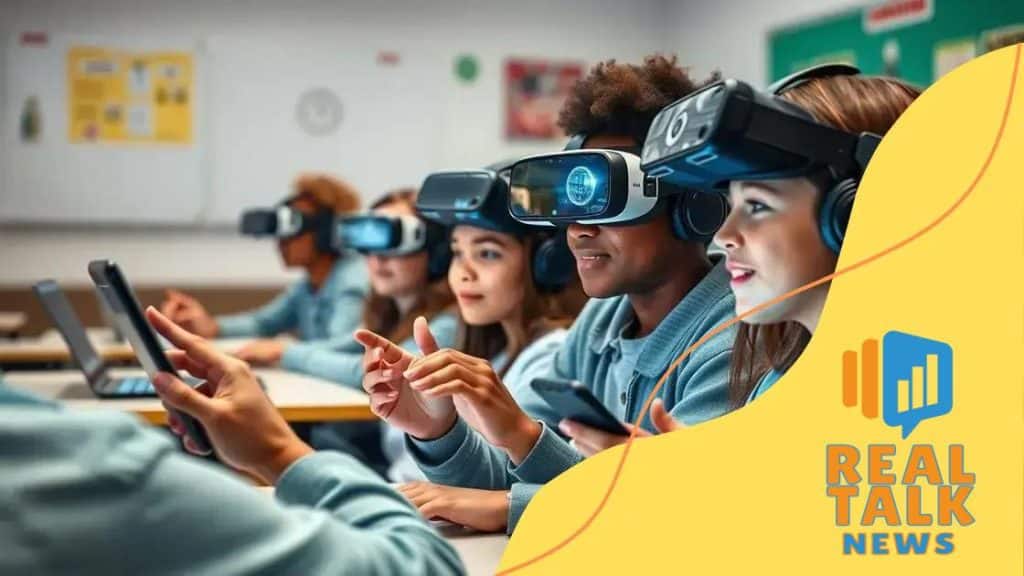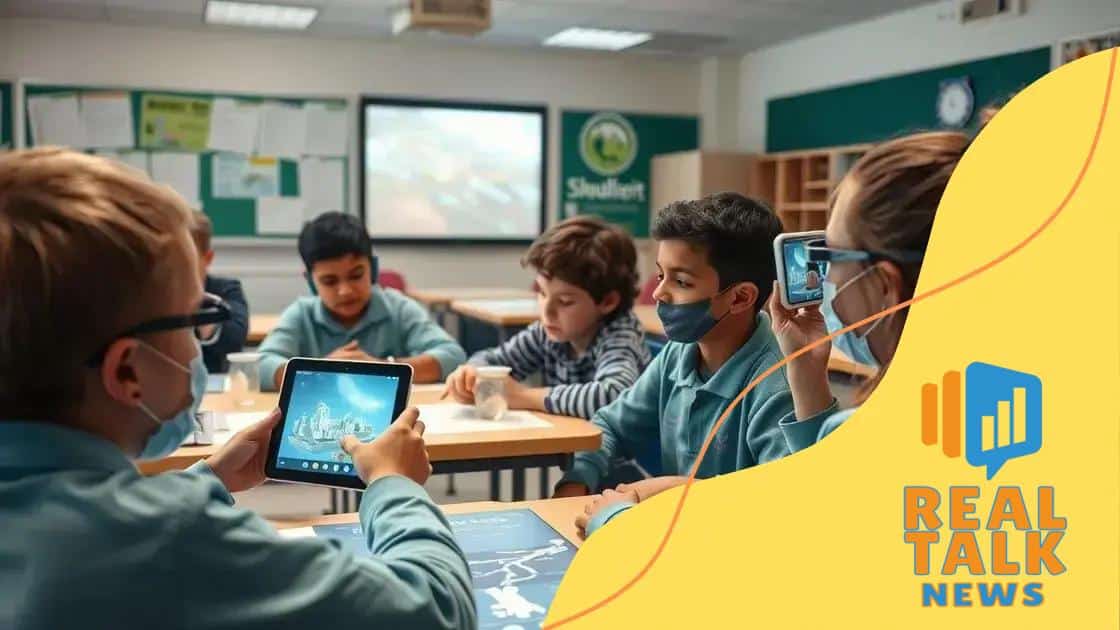How AR is being used for hands-on learning experiences

Augmented reality (AR) is transforming education by providing interactive and immersive learning experiences, enhancing engagement, and enabling personalized and collaborative learning opportunities across various subjects.
How AR is being used for hands-on learning experiences is becoming a game-changer in education. Imagine students exploring virtual environments, making lessons interactive and memorable. Curious about how this technology enhances learning? Let’s dive in.
The role of augmented reality in education
In recent years, augmented reality (AR) has become an essential tool in education, transforming traditional learning methods. By integrating digital information with the real world, AR creates engaging and interactive experiences for students.
Teachers can now bring subjects to life, making classes more dynamic and retaining student interest. AR technology allows learners to visualize complex concepts and explore new environments in a hands-on way.
Enhancing Engagement
One of the key roles of AR in education is enhancing student engagement. When students can interact with their lessons, they are more likely to participate actively.
- AR captures attention quickly.
- It promotes collaboration among students.
- Hands-on experiences can increase retention rates.
Moreover, schools are using AR to create gamified learning experiences, where students can solve challenges or explore historical events in immersive ways.
Bridging Learning Gaps
Augmented reality also plays a crucial role in bridging learning gaps among students. Children who struggle in traditional environments can benefit significantly from AR tools.
For instance, students with different learning styles can interact with the content at their own pace. AR can present information visually and audibly, catering to various preferences. By using AR, educators can meet individual needs effectively.
Furthermore, the examples of AR applications in education are diverse. From virtual field trips to 3D models of the human body, students gain access to experiences they might not have otherwise. This exposure enriches their knowledge and inspires curiosity.
Benefits of AR for hands-on learning
The benefits of augmented reality (AR) for hands-on learning are extensive and profound. By blending the digital and physical worlds, AR creates unique educational experiences that engage students more effectively than traditional methods.
One significant advantage is that AR allows for personalized learning opportunities. Students can interact with content at their own pace, making complex subjects easier to understand. This tailored approach helps cater to various learning styles.
Increased Motivation
Students are often more motivated when using AR tools. The immersive nature of AR technology captivates their attention and encourages exploration.
- Engaging visuals spark curiosity.
- Interactive activities make learning fun.
- Gamification of lessons promotes a competitive spirit.
As a result, students are more likely to retain information and participate in class discussions. These motivating factors are essential for fostering a positive learning environment.
Enhanced Understanding of Concepts
Another benefit of AR is the ability to visualize complex topics. For instance, instead of memorizing anatomy diagrams, students can view 3D models of the human body, allowing them to see how systems interact.
This kind of visual exploration can deepen understanding and retention. When students can see and manipulate data or concepts, the learning experience becomes much richer and more impactful.
Furthermore, hands-on learning with AR enables students to apply their knowledge in practical settings. They can simulate real-world situations, making connections between theory and practice. This application enhances critical thinking and problem-solving skills that are vital in today’s world.
Examples of AR applications in classrooms

There are many examples of augmented reality (AR) applications in classrooms that showcase its growing importance in education. These applications enhance learning by making it more interactive and engaging for students.
For instance, one popular AR app allows students to explore the solar system by overlaying virtual planets onto a physical environment. This interactive experience helps students visualize distances and sizes in a way that textbooks cannot achieve.
Interactive Learning Experiences
Another significant example is using AR to learn about historical events. With specific apps, students can point their devices at images or objects and see animations of key moments in history.
- Virtual field trips can take students to landmarks around the world.
- 3D models of ancient ruins can enhance understanding of architecture.
- AR can recreate battles, giving students a new perspective on historical events.
This interactive learning engages students and deepens their understanding of the subject matter.
Science and Biology Lessons
In science classes, AR applications let students examine complex biological systems. For instance, students can use AR to dissect virtual frogs or explore the human body.
This hands-on approach fosters a greater understanding of anatomy and physiology, making information memorable. Learning about systems and organs becomes an exciting adventure rather than a tedious memorization task.
Furthermore, AR can be integrated into math lessons, where students can visualize geometric shapes and solve problems in a 3D space. This technique encourages creative thinking and problem-solving skills, essential for their future.
Challenges and considerations in using AR
While there are many benefits to using augmented reality (AR) in education, there are also challenges and considerations that educators must address. Understanding these challenges is crucial to effectively implementing AR in the classroom.
One major issue is the need for technology. Schools often require devices such as tablets or smartphones, which may not be available to every student. This lack of access can create disparities in learning opportunities.
Technical Issues
Another significant challenge is the potential for technical difficulties. Connectivity issues or software glitches can disrupt lessons and frustrate both teachers and students. Ensuring a stable internet connection and having reliable software are essential for a seamless AR experience.
- Training teachers to use AR effectively is vital.
- Proper maintenance of devices is necessary to minimize downtime.
- Awareness of troubleshooting methods can help resolve issues quickly.
Additionally, educators need to be aware of the educational content available. Not all AR applications are created equal. Some may not align well with curriculum standards, making it crucial to evaluate resources carefully.
Planning and Integration
Proper planning and integration of AR into lessons can also present challenges. Teachers need to decide when and how to incorporate AR to maximize its effectiveness. Without a clear strategy, AR can become an add-on rather than an integral part of the learning process.
Moreover, educators should consider the cognitive load on students. Introducing AR can be overwhelming for some learners, especially if they are not accustomed to using technology in the classroom. It’s essential to introduce AR gradually, allowing students to adapt at a comfortable pace.
Future trends of AR in education
The future trends of augmented reality (AR) in education are exciting and promising. As technology continues to advance, educators and students will experience more innovative ways of learning. This integration of AR presents avenues for enhancing educational methods and engagement.
One emerging trend is the use of AR to create personalized learning experiences. As technology evolves, applications will be able to adapt to individual student needs. This means that lessons can be tailored based on a student’s progress, learning style, and interest.
Collaborative Learning Environments
Another significant trend is fostering collaborative learning through AR. Students will have opportunities to work together in virtual spaces, regardless of their physical location.
- Group projects can incorporate AR for richer presentations.
- Students can share their AR experiences during class discussions.
- Collaborative problem-solving can be enhanced with interactive simulations.
This cooperation promotes teamwork skills and prepares students for the collaborative nature of the modern workplace.
Integration with Artificial Intelligence
Additionally, the integration of AR with artificial intelligence (AI) will transform educational experiences. Intelligent systems can analyze student interactions with AR applications to offer instant feedback and support.
This combination can lead to smart tutoring systems that assist students in real-time, ensuring they understand the material. As these technologies develop, they will make learning more efficient and effective.
Furthermore, we will likely see AR applications that create immersive simulations, allowing students to practice skills in safe environments. For example, medical students can perform virtual surgeries, gaining hands-on experience without any risks. This kind of practice prepares them for real-life situations and builds confidence.
In conclusion, augmented reality (AR) is revolutionizing education by making learning more interactive and engaging. As we look to the future, we can expect AR applications to become more personalized, collaborative, and integrated with advanced technologies like artificial intelligence. This evolution will create opportunities for students to learn in immersive ways, helping them grasp complex concepts and apply their knowledge practically. By overcoming challenges and embracing these innovations, educators can significantly enhance the educational experience for all students.
FAQ – Frequently Asked Questions about Augmented Reality in Education
How can augmented reality enhance learning experiences?
Augmented reality makes learning more interactive and engaging, helping students visualize complex concepts and retain information better.
What are some examples of AR applications in classrooms?
Examples include virtual field trips, 3D anatomy models, and interactive historical reenactments, which all promote hands-on learning.
What challenges might schools face when implementing AR?
Challenges may include access to devices, technical issues, and the need for teacher training to effectively integrate AR into lessons.
What future trends can we expect for AR in education?
Future trends include personalized learning experiences, collaboration through virtual spaces, and integration with artificial intelligence for real-time feedback.





